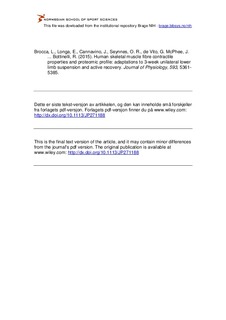| dc.contributor.author | Brocca, Lorenza | |
| dc.contributor.author | Longa, Emanuela | |
| dc.contributor.author | Cannavino, Jessica | |
| dc.contributor.author | Seynnes, Olivier R. | |
| dc.contributor.author | de Vito, Giuseppe | |
| dc.contributor.author | McPhee, Jamie | |
| dc.contributor.author | Narici, Marco | |
| dc.contributor.author | Pellegrino, Maria Antonietta | |
| dc.contributor.author | Bottinelli, Roberto | |
| dc.date.accessioned | 2016-09-05T08:15:13Z | |
| dc.date.available | 2016-09-05T08:15:13Z | |
| dc.date.issued | 2015-12-15 | |
| dc.identifier.citation | Journal of Physiology. 2015, 593, 5361-5385 | nb_NO |
| dc.identifier.uri | http://hdl.handle.net/11250/2404174 | |
| dc.description | Dette er siste tekst-versjon av artikkelen, og den kan inneholde små forskjeller fra forlagets pdf-versjon. Forlagets pdf-versjon finner du på www.wiley.com / This is the final text version of the article, and it may contain minor differences from the journal's pdf version. The original publication is available at www.wiley.com | nb_NO |
| dc.description.abstract | Following disuse, muscle fibre function goes through adaptations such as a loss of specific force (PO/CSA) and an increase in unloaded shortening velocity, which could be a result of both quantitative changes (i.e. atrophy) and qualitative changes in protein pattern. The underlying mechanisms remain to be clarified. In addition, little is known about the recovery of muscle mass and strength following disuse. In the present study, we report an extensive dataset describing, in detail,the functional and protein content adaptations of skeletal muscle in response to both disuse and re-training. Eight young healthy subjects were subjected to 3 weeks of unilateral lower limb suspension (ULLS), a widely used human model of disuse skeletal muscle atrophy. Needle biopsies samples were taken from the vastus lateralis muscle Pre-ULLS, Post-ULLS and after 3 weeks of recovery during which heavy resistance training was performed. After disuse, cross-sectional area (CSA), PO/CSA and myosin concentration (MC) decreased in both type 1 and 2A skinned muscle fibres. After recovery, CSA and MC returned to levels comparable to those observed before disuse, whereas Po/CSA and unloaded shortening velocity reached a higher level. Myosin heavy chain isoform composition of muscle samples did not differ among the experimental groups. To study the mechanisms underlying such adaptations, a two-dimensional proteomic analysis was performed. ULLS induced a reduction of myofibrillar, metabolic (glycolytic and oxidative) and anti-oxidant defence system protein content. Resistance training was very effective in counteracting ULLS-induced alterations, indicating that long-term ULLS did not prevent the positive effect of exercise on human muscle. | nb_NO |
| dc.language.iso | eng | nb_NO |
| dc.publisher | The Physiological Society | nb_NO |
| dc.subject | actins/metabolism | |
| dc.subject | adolescent | |
| dc.subject | adult | |
| dc.subject | humans | |
| dc.subject | leg/physiology | |
| dc.subject | *muscle contraction | |
| dc.subject | muscle fibers, skeletal/*metabolism/physiology | |
| dc.subject | muscular atrophy/etiology/*metabolism/therapy | |
| dc.subject | myosins/metabolism | |
| dc.subject | proteome/*metabolism | |
| dc.subject | recovery of function | |
| dc.subject | resistance training | |
| dc.subject | restraint, physical/adverse effects | |
| dc.title | Human skeletal muscle fibre contractile properties and proteomic profile: adaptations to 3 weeks of unilateral lower limb suspension and active recovery | nb_NO |
| dc.type | Journal article | nb_NO |
| dc.type | Peer reviewed | nb_NO |
| dc.subject.nsi | VDP::Mathematics and natural science: 400::Basic biosciences: 470 | nb_NO |
| dc.source.journal | Journal of Physiology | nb_NO |
| dc.identifier.doi | 10.1113/JP271188 | |
| dc.description.localcode | Seksjon for fysisk prestasjonsevne / Department of Physical Performance | nb_NO |
